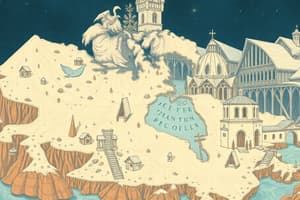Podcast
Questions and Answers
Which of these is NOT a landform region in Canada?
Which of these is NOT a landform region in Canada?
- Western Cordillera
- Canadian Shield
- Interior Plains
- Desert Region (correct)
What is temperature range?
What is temperature range?
The difference between the highest and lowest temperatures recorded over a specific period.
A continental climate is characterized by mild temperatures year-round.
A continental climate is characterized by mild temperatures year-round.
False (B)
What defines a maritime climate?
What defines a maritime climate?
What does the adiabatic lapse rate refer to?
What does the adiabatic lapse rate refer to?
What is global warming?
What is global warming?
What is the greenhouse effect?
What is the greenhouse effect?
Carbon sinks absorb more carbon dioxide than they ______.
Carbon sinks absorb more carbon dioxide than they ______.
Flashcards are hidden until you start studying
Study Notes
Landform Regions
- Canada’s diverse landscape includes the Western Cordillera, the Interior Plains, the Canadian Shield, the Appalachian Mountains, the Great Lakes-St.Lawrence Lowlands, the Arctic and Hudson Bay Lowlands, and the Boreal Forest.
- Each region has characteristics that make Canada’s landscape unique, such as mountains, flat grasslands, rocky areas, rolling hills, and forests.
- The Western Cordillera includes tall mountains and valleys that were formed by tectonic plate movement.
- The Interior Plains are flat and characterized by grasslands, which make it a fertile area for farming.
- The Canadian Shield is a rocky region filled with many lakes and forests. This region is known for its mineral resources.
- The Appalachian Mountains in the east are older and feature rolling hills and forests.
- The Great Lakes-St. Lawrence Lowlands are flat and fertile with many cities and farms.
- The Arctic and Hudson Bay Lowlands are cold and flat regions with tundra and permafrost.
- The expansive Boreal Forest, also known as the taiga, stretches across a significant portion of Canada.
- The Boreal Forest is rich in biodiversity and plays a vital role in regulating climate.
Types and Calculations of Climate
- Climate is the long-term weather patterns of a region.
- It is influenced by factors such as temperature, precipitation, and humidity.
- The temperature range is the difference between the highest and lowest temperatures in a specific period.
- A continental climate experiences large temperature variations between seasons, with hot summers and cold winters.
- Continental climates are found far from large bodies of water.
- A maritime climate is influenced by the presence of oceans or large bodies of water.
- Maritime climates experience milder winters and cooler summers due to the moderating effect of water.
- The adiabatic lapse rate refers to the rate at which air temperature decreases as altitude increases.
Factors Affecting Climate
- The adiabatic lapse rate explains why air temperature decreases as altitude increases.
- The latitude of a region influences its climate, with areas closer to the equator experiencing warmer temperatures than those at higher latitudes.
- The presence of mountains can create rain shadows on one side, while valleys can trap cool air in the winter.
- Ocean currents affect the climate of coastal areas, leading to warmer or cooler temperatures than inland regions.
- Wind patterns play a role in distributing heat and moisture, creating different climatic zones.
Global Warming
- Global warming refers to the gradual increase in Earth’s average surface temperature due to the buildup of greenhouse gases in the atmosphere.
- Greenhouse gases trap heat from the sun, leading to a rise in global temperatures.
- Human activities, such as burning fossil fuels, deforestation, and industrial processes, are the main drivers of global warming.
- The impacts of global warming include rising sea levels, more frequent extreme weather events, and disruptions to ecosystems.
Greenhouse Effect
- The greenhouse effect is a natural process that warms Earth’s surface.
- Greenhouse gases, such as carbon dioxide, methane, water vapor, and nitrous oxide, absorb and re-radiate heat from the sun, trapping it in the atmosphere.
- The amplified greenhouse effect due to human activities is contributing to global warming.
Carbon Sinks and Sources
- Carbon sinks absorb more carbon dioxide (CO2) from the atmosphere than they release.
- Examples include forests, oceans, and wetlands.
- Carbon sources release more CO2 into the atmosphere than they absorb, such as burning fossil fuels, deforestation, and industrial processes.
- Carbon sinks and sources are essential to regulating the amount of CO2 in the atmosphere.
- Maintaining healthy carbon sinks is crucial to mitigating climate change.
Studying That Suits You
Use AI to generate personalized quizzes and flashcards to suit your learning preferences.




